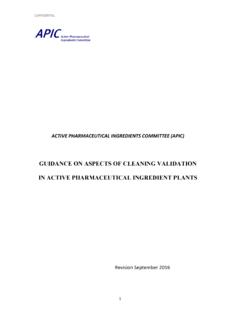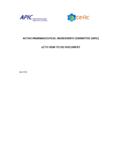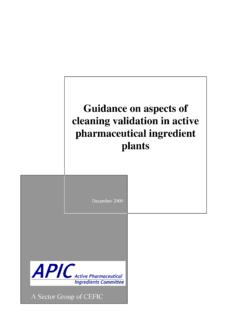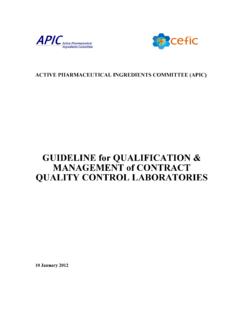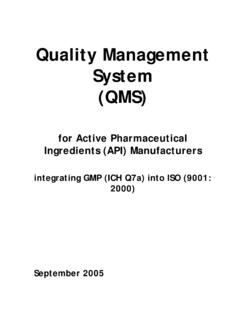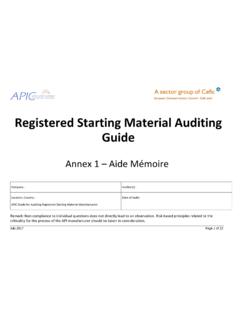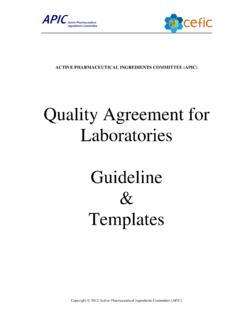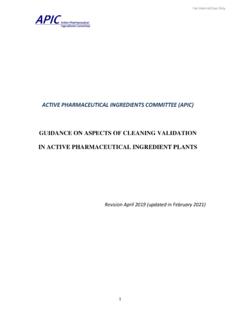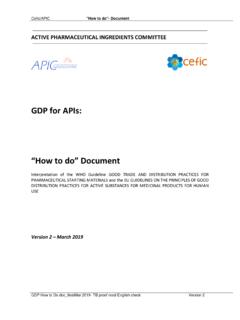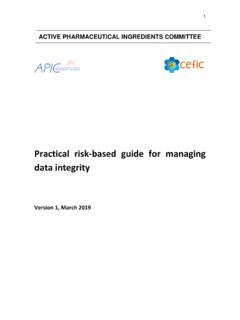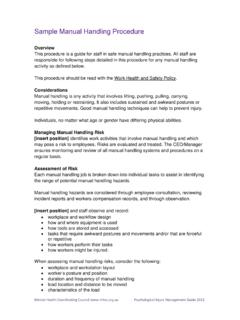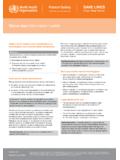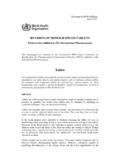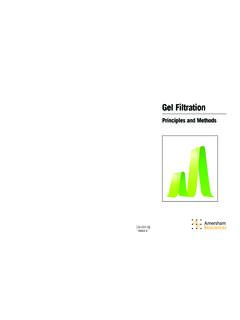Transcription of Guidance on Handling of Insoluble Matter and Foreign ...
1 _____ Page 1 of 19 ACTIVE PHARMACEUTICAL INGREDIENTS COMMITTEE (APIC) Guidance on Handling of Insoluble Matter and Foreign Particles in APIs Version 01 June 2015 APIC Guidance on Insoluble Matter and Foreign Particles in APIs Page 2 of 19 Disclaimer This document represents voluntary Guidance for API manufacturers and their customers, and the contents should not be interpreted as regulatory requirements. Alternative approaches than those described here may also be used. Foreword The CEFIC* Sector Group APIC (the Active Pharmaceutical Ingredients Committee) was founded in 1992 as a direct consequence of the rapidly increasing European regulatory requirements affecting the manufacture of Active Pharmaceutical Ingredients (APIs). APIC represents producers of APIs and API intermediates in Europe. Its membership consists of more than 60 companies, located all over Europe, and of several national industry associations.
2 For around 2/3 of its members, selling APIs and intermediates is their major business while ca. 1/3 of the members are primarily marketing final medicinal products. APIC s focus is on worldwide Quality, Good Manufacturing Practice (GMP) and Regulatory matters relating to APIs and intermediates. Through the years APIC has developed into a high-profile industry association with an excellent, worldwide reputation. APIC has already developed a series of Guidance documents and position papers (see ). This document offers best industry practice and Guidance for appropriate controls for the unavoidable presence of minute amounts of particles in APIs. The guideline highlights potential factors to minimize patient risk within reasonable limits. If you have any comments or suggestions for further improvement please contact the APIC Secretary at: CEFIC Active Pharmaceutical Ingredients Committee (APIC) Av.
3 E. Van Nieuwenhuyse 4 / box 2 B - 1160 Brussels Tel: +32 2 676 72 02 or +32 2 676 72 44 Fax: + 32 2 676 73 59 E-mail : or * CEFIC (the European Chemical Industry Council): The Brussels-based organisation that represents the European Chemical Industry APIC Guidance on Insoluble Matter and Foreign Particles in APIs Page 3 of 19 Table of contents 1. Acknowledgements 2. Introduction and Purpose Purpose Background 3. Scope 4. Definitions of Particles Particles in final APIs Particles in API intermediates Particles in Raw Materials (including packaging materials) for APIs 5. Good practices to minimize the presence of particles in APIs Key preventive measures Removal / detection methods Inspection methods. 6. Analytical Controls and Acceptance Criteria General rules for APIs Analytical Methods for APIs Appearance Test Filter Test Sampling and Sample Size Preventive measures for the test execution Test Execution Acceptance Criteria for APIs Dosage Forms and route of administration.
4 Limits (In-)Process Controls for Intermediate Process Steps 7. Incident Management Determination of identity of particles. Identify source examples of investigation techniques and aids. CAPA / course of action to avoid reoccurrence. Risk Assessment: topics to be considered during the investigation & disposition decision 8. References 9. Glossary APIC Guidance on Insoluble Matter and Foreign Particles in APIs Page 4 of 19 1. Acknowledgements This document was drawn up by a group of experts within CEFIC / APIC. We cordially thank them for their hard work and efforts spent as well as for their kind cooperation, intensive discussions and fruitful comments: Ulrich Fechtel Merck KGaA Rainer Fendt BASF SE Shahar Mozes Teva Pharmaceutical Industries Ltd Hermann M ller-B tticher Boehringer-Ingelheim Dirk Overr dder J&J, Cilag (Chair) Luisa Paulo Hovione FarmaCiencia SA Wilbert Van de Rakt Aspen Oss Matthias Wenzel BASF Pharma Chemikalien GmbH Bob Johnson Lonza Ltd Neil Mold MacFarlane Smith Jens Woeltinger Evonik Industries AG Chris Oates UQUIFA Paulo Castro Hovione FarmaCiencia SA We like to express our sincere gratitude to IPEC (the International Pharmaceutical Excipients Council) for its kind permission to consider the Technically Unavoidable Particle Profile Guide , 2013 [see Referencea] in the development of this APIC guideline].
5 We also like to thank anybody else who has, as a quality or regulatory professional from pharmaceutical industry or as member of any industry association, given valuable input to the generation of this document. APIC Guidance on Insoluble Matter and Foreign Particles in APIs Page 5 of 19 2. Introduction and Purpose The subject of particles (sometimes referred to as visible particles, Insoluble particles / Matter or Foreign particles) in Active Pharmaceutical Ingredients (APIs) and related intermediates has been, and continues to be, a topic of great interest and importance to the pharmaceutical industry. Particles have always been present in APIs but the interest and concern has risen due to an increased number of inspectional observations from various Regulatory Authorities concerning visible particles in Drug Products and APIs.
6 The elevated presence of particles as well as inappropriate methods of investigation, controls and preventive and/or corrective actions were all subjects of citations by authorities and observations by API customers. Currently the Guidance from health authorities (EMA, FDA, others) or Pharmacopoeias ( EP, USP) about particles in APIs is very limited1. This lack of Guidance has led to uncertainty of how to deal with Insoluble Matter , and has sometimes resulted in the unrealistic expectation that no single visible particle should be present in any amount of API, irrespective of its size or the overall amount present in a batch. Therefore the idea was born to develop such a Guidance document as a basis for common understanding regarding the presence of particles in APIs. Purpose This document intends to provide Guidance to the API/intermediate industry, API users, API customers, suppliers of raw materials and other stakeholders for a standard approach towards the establishment of acceptable limits for the presence of particles, and Guidance on appropriate investigation of any deviations from these limits in Active Pharmaceutical Ingredients (APIs) and API Intermediates.
7 It is obvious that a detailed Guidance document will provide the following benefits to the industry and to Health Authorities: Provide a basis for a common understanding regarding the presence of particles in APIs; Provide current scientific, process, analytical, equipment and engineering knowledge, and proven good practices, to minimize the presence and risk of particles in APIs; Provide proven test methods and scientifically based acceptance criteria for particles in APIs; Share possible investigation tools to support the systematic and faster identification of root cause, appropriate corrective/preventive actions and risk assessments to enable the Quality Unit to make a solid GMP oriented final product disposition decision. This guideline suggests the various measures and processes that could be applied to minimize the presence of Insoluble Matter down to acceptable levels, to establish appropriate controls, and therefore helps to ensure a more reliable supply chain.
8 This Guidance assumes full compliance with relevant GMPs ( good engineering, maintenance, documentation practices). 1 Remark: Examples of current regulatory expectations include parenteral or ophthalmic drug product applications, essentially free from visible particles USP <790>, practically free from particles (Ph. Eur.), Particulate contamination: visible particles APIC Guidance on Insoluble Matter and Foreign Particles in APIs Page 6 of 19 Background The United States FD&C Act - Subchapter A - [351]b) states that a drug or device shall be deemed to be adulterated - (a)(1) if it consists in whole or in part of any filthy, putrid, or decomposed substance; or (2)(A) if it has been prepared, packed, or held under insanitary conditions, whereby it may have been contaminated with filth, or whereby it may have been rendered injurious to (Remark: only the most relevant part of this subchapter has been copied from FD&C Act) The presence of particles in API can be considered product adulteration if an absolute interpretation of the FD and C Act is made.
9 However, the regulation and its preamble recognize that manufacturers cannot provide 100 % assurance that all active ingredients manufactured will be free from one form of contamination or another. The preamble also states the procedures must be designed to prevent contamination. This implies an acknowledgement that procedures cannot fully guarantee contamination prevention. Moreover, the preamble also states that the level of concern for contamination will be dependent upon the final application of the drug product and the related risk to the patient. The regulation therefore recognizes the fact that any contact between two different materials results in some physico-chemical interaction, especially when mechanical force or other kind of energy is applied ( stirring, filtering, milling), but also requires that the degree of interaction is minimized by equipment design and selection of materials of construction.
10 API manufacturers carefully select equipment construction and other materials for their inertness / compatibility with process streams, and on the basis of safety characteristics ( food grade oils, plastics, packaging materials), because the presence of trace amounts of such materials in an API can never be totally excluded, while not immediately apparent they can be detected if sufficient analytical effort is applied. Because of these selection criteria, the presence of trace amounts of such inherently safe materials are process related and can hardly be considered as being filthy, putrid, or decomposed substances . To summarize: Such traces of equipment construction materials and process contact materials in products (intermediates or APIs) are: Unavoidable; Minimized by selection of inherently safe materials with high (but not unlimited) resistance against mechanical / chemical interaction with processed materials; Their presence or absence at intermediate synthesis steps is potentially not relevant, as subsequent steps such as filtrations or purifications will remove them; Controlled at the level of the API by means of a variety of non-specific tests during routine QC testing which are generally able to detect visible particles in the parts per million range.
